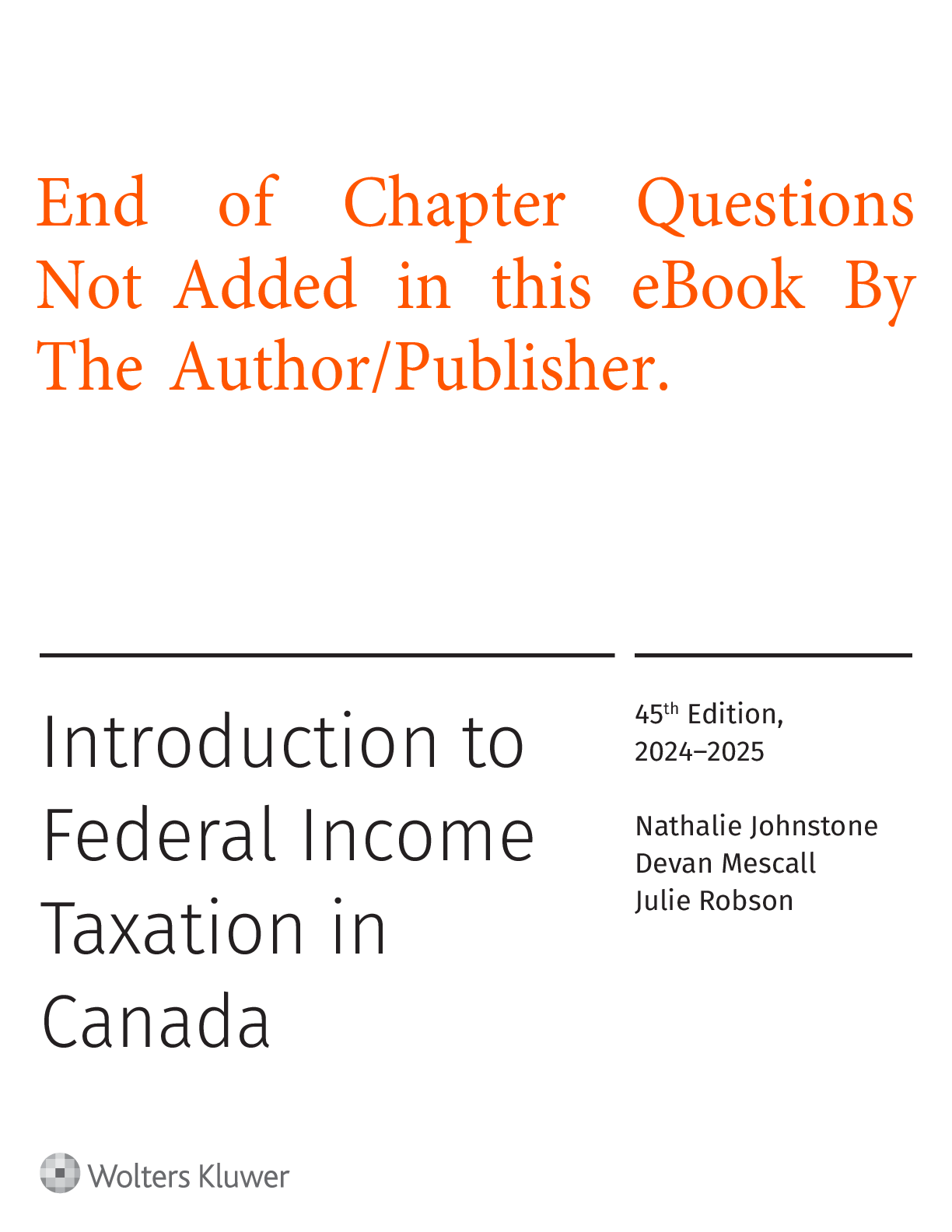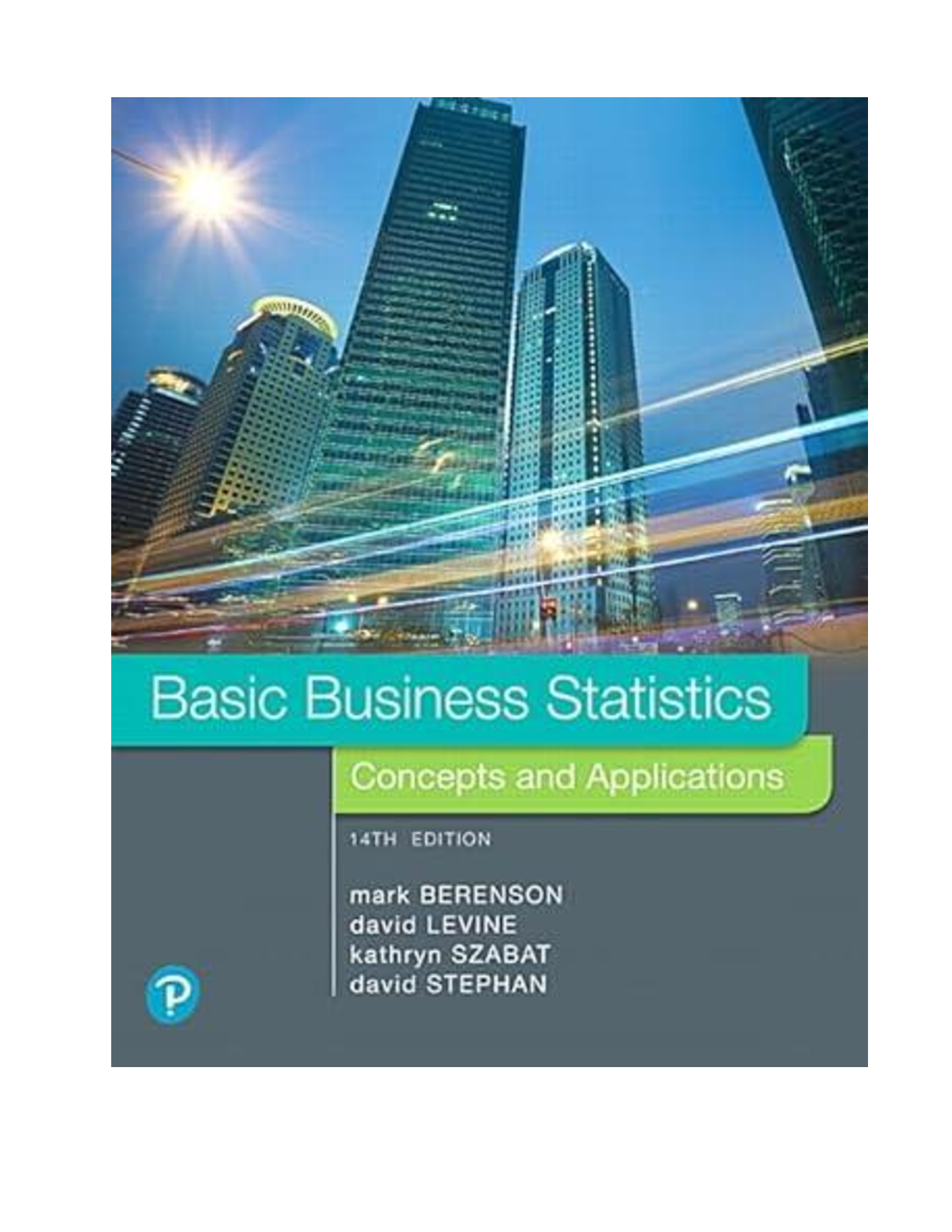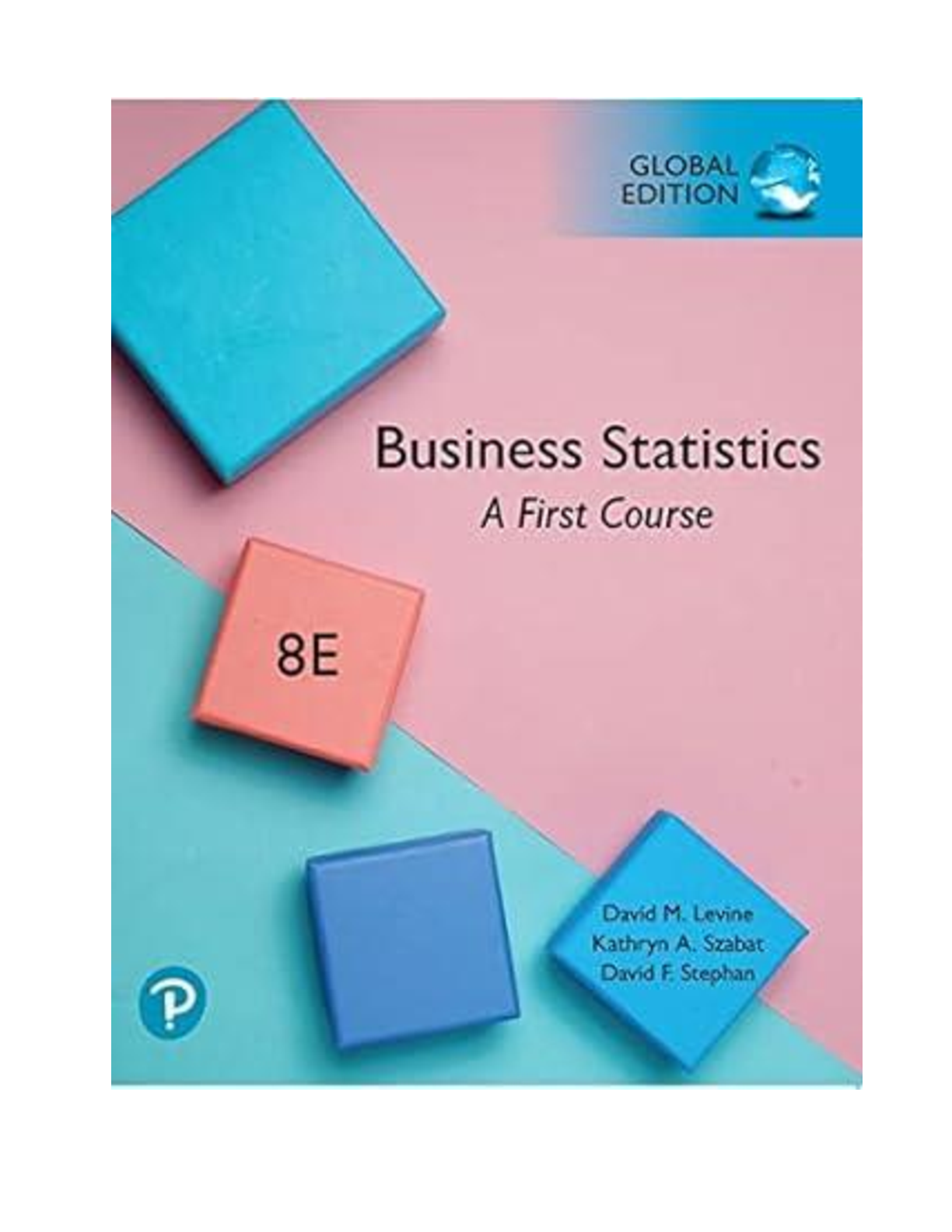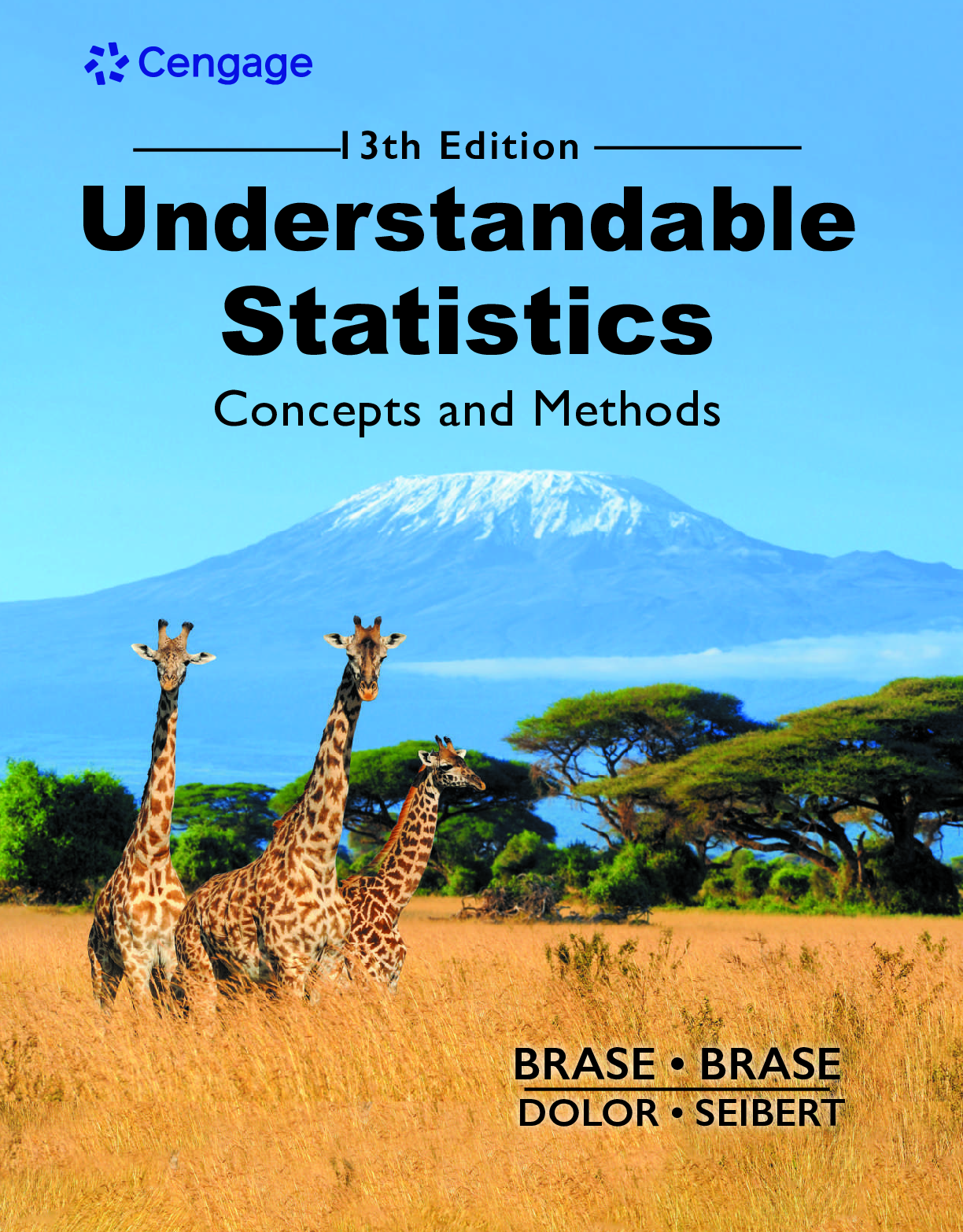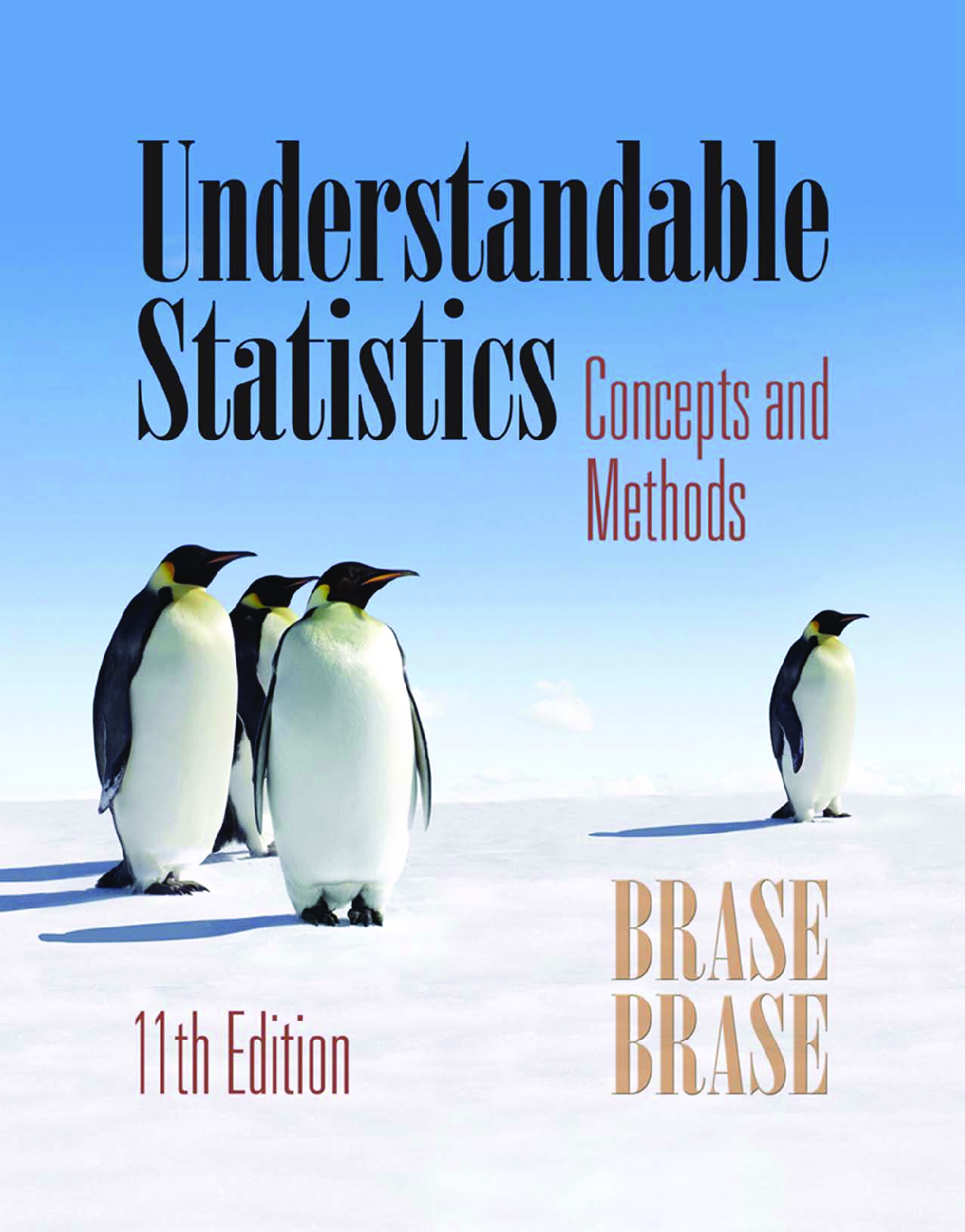Statistics > eBook-PDF > Basic Business Statistics Concepts and Applications, 14th Edition By Mark Berenson, David Levine, Ka (All)
Basic Business Statistics Concepts and Applications, 14th Edition By Mark Berenson, David Levine, Kathryn Szabat (eBook PDF)
Document Content and Description Below
A Roadmap for Selecting a Statistical Method Basic Business Statistics Concepts and Applications Basic Business Statistics Concepts and Applications About the Authors Brief Contents Contents Pre... face What’s New in this Edition? Continuing Features that Readers Have Come to Expect Chapter-by-Chapter Changes Made for this Edition Serious About Writing Improvements A Note of Thanks Contact Us! First Things First Contents Objectives FTF.1 Think Differently About Statistics Statistics: A Way of Thinking DCOVA Framework Analytical Skills More Important than Arithmetic Skills Statistics: An Important Part of Your Business Education FTF.2 Business Analytics: The Changing Face of Statistics “Big Data” Unstructured data FTF.3 Starting Point for Learning Statistics Statistic Can Statistics (pl., statistic) Lie? FTF.4 Starting Point for Using Software Using Software Properly Software instruction conventions and notation References Key Terms Excel Guide EG.1 Getting Started with Excel EG.2 Entering Data EG.3 Open or Save a Workbook EG.4 Working with a Workbook EG.5 Print a Worksheet EG.6 Reviewing Worksheets EG.7 If You Use the Workbook Instructions JMP Guide JG.1 Getting Started with JMP JG.2 Entering Data JG.3 Create New Project or Data Table JG.4 Open or Save Files JG.5 Print Data Tables or Report Windows JG.6 JMP Script Files Minitab Guide MG.1 Getting Started with Minitab MG.2 Entering Data MG.3 Open or Save Files MG.4 Insert or Copy Worksheets MG.5 Print Worksheets 1 Defining and Collecting Data Contents Objectives 1.1 Defining Variables Solution Classifying Variables by Type Measurement Scales Problems for Section 1.1 Learning the Basics Applying the Concepts 1.2 Collecting Data Populations and Samples Data Sources Problems for Section 1.2 Applying the Concepts 1.3 Types of Sampling Methods Simple Random Sample Systematic Sample Stratified Sample Cluster Sample Problems for Section 1.3 Learning the Basics Applying the Concepts 1.4 Data Cleaning Invalid Variable Values Coding Errors Data Integration Errors Missing Values Algorithmic Cleaning of Extreme Numerical Values 1.5 Other Data Preprocessing Tasks Data Formatting Stacking and Unstacking Data Recoding Variables Problems for Sections 1.4 and 1.5 Applying the Concepts 1.6 Types of Survey Errors Coverage Error Nonresponse Error Sampling Error Measurement Error Ethical Issues About Surveys Problems for Section 1.6 Applying the Concepts Summary References Key Terms Checking Your Understanding Chapter Review Problems Managing Ashland MultiComm Services CardioGood Fitness Clear Mountain State Student Survey Learning with the Digital Cases Chapter 1 Excel Guide EG1.1 Defining Variables Classifying Variables by Type EG1.2 Collecting Data EG1.3 Types of Sampling Methods Simple Random Sample Key Technique Example 1 Workbook Analysis ToolPak Example 2 PHStat Workbook EG1.4 Data Cleaning EG1.5 Other Data Preprocessing Recoding Variables Key Technique Example Workbook Chapter 1 JMP Guide JG1.1 Defining Variables Classifying Variables by Type JG1.2 Collecting Data JG1.3 Types of Sampling Methods Simple Random Sample and Stratified Sample Systematic Sample JG1.4 Data Cleaning JG1.5 Other Preprocessing Tasks Stacking and Unstacking Variables Recoding Variables Chapter 1 Minitab Guide MG1.1 Defining Variables Classifying Variables by Type MG1.2 Collecting Data MG1.3 Types of Sampling Methods Simple Random Samples MG1.4 Data Cleaning MG1.5 Other Preprocessing Tasks Recoding Variables 2 Organizing and Visualizing Variables Contents Objectives 2.1 Organizing Categorical Variables The Summary Table Solution The Contingency Table Problems for Section 2.1 Learning the Basics Applying the Concepts 2.2 Organizing Numerical Variables The Frequency Distribution Solution The Relative Frequency Distribution and the Percentage Distribution Solution The Cumulative Distribution Solution Problems for Section 2.2 Learning the Basics Applying the Concepts 2.3 Visualizing Categorical Variables The Bar Chart Solution The Pie Chart and the Doughnut Chart Solution The Pareto Chart Solution Visualizing Two Categorical Variables The Side-by-Side Chart The doughnut chart Problems for Section 2.3 Applying the Concepts 2.4 Visualizing Numerical Variables The Stem-and-Leaf Display The Histogram Solution Solution The Percentage Polygon Solution The Cumulative Percentage Polygon (Ogive) Solution Problems for Section 2.4 Learning the Basics Applying the Concepts 2.5 Visualizing Two Numerical Variables The Scatter Plot Solution The Time-Series Plot Solution Problems for Section 2.5 Learning the Basics Applying the Concepts 2.6 Organizing a Mix of Variables Drill-down 2.7 Visualizing a Mix of Variables Colored Scatter Plot Bubble Charts PivotChart (Excel) Treemap (Excel, JMP) Sparklines (Excel) 2.8 Filtering and Querying Data Excel Slicers Problems for Sections 2.6 through 2.8 Applying the Concepts 2.9 Pitfalls in Organizing and Visualizing Variables Obscuring Data Creating False Impressions Chartjunk Problems for Section 2.9 Applying the Concepts Summary References Key Equations Determining the Class Interval Width Computing the Proportion or Relative Frequency Key Terms Checking Your Understanding Chapter Review Problems Report Writing Exercises Managing Ashland MultiComm Services Digital Case CardioGood Fitness The Choice Is Yours Follow-Up Clear Mountain State Student Survey Chapter 2 Excel Guide EG2.1 Organizing Categorical Variables The Summary Table Key Technique Example PHStat Workbook (untallied data) Workbook (tallied data) The Contingency Table Key Technique Example PHStat (untallied data) Workbook (untallied data) Workbook (tallied data) EG2.2 Organizing Numerical Variables The Ordered Array The Frequency Distribution Key Technique Example PHStat (untallied data) Workbook (untallied data) Analysis ToolPak (untallied data) The Relative Frequency, Percentage, and Cumulative Distributions Key Technique Example PHStat (untallied data) Workbook (untallied data) Analysis ToolPak EG2 Charts Group Reference EG2.3 Visualizing Categorical Variables The Bar Chart and the Pie (or Doughnut) Chart Key Technique Example PHStat Workbook The Pareto Chart Key Technique Example PHStat Workbook The Side-by-Side Chart Key Technique Example PHStat Workbook EG2.4 Visualizing Numerical Variables The Stem-and-Leaf Display Key Technique Example PHStat Workbook The Histogram Key Technique Example PHStat Workbook Analysis ToolPak Use Histogram. The Percentage Polygon and the Cumulative Percentage Polygon (Ogive) Key Technique Example PHStat Workbook EG2.5 Visualizing Two Numerical Variables The Scatter Plot Key Technique Example PHStat Workbook The Time-Series Plot Key Technique Example Workbook EG2.6 Organizing a Mix of Variables Multidimensional Contingency Tables Key Technique Example Workbook Adding a Numerical Variable Key Technique Example Workbook EG2.7 Visualizing a Mix of Variables PivotChart Key Technique Example Workbook Treemap Key Technique Example Workbook Sparklines Key Technique Example Workbook EG2.8 Filtering and Querying Data Chapter 2 JMP Guide JG2 JMP Choices for Creating Summaries JG2.1 Organizing Categorical Variables The Summary Table (classical) The Summary Table (interactive) The Contingency Table JG2.2 Organizing Numerical Variables The Ordered Array The Frequency, Relative Frequency, Percentage, and Cumulative Percentage Distributions Cumulative Percentages. Classes JG2.3 Visualizing Categorical Variables The Bar Chart or the Pie Chart The Pareto Chart Visualizing Two Categorical Variables JG2.4 Visualizing Numerical Variables The Stem-and-Leaf Display The Histogram The Percentage Polygon and the Cumulative Percentage Polygon (Ogive) Percentage Polygons. Cumulative Percentage Polygons. JG2.5 Visualizing Two Numerical Variables The Scatter Plot The Time-Series Plot JG2.6 Organizing a Mix of Variables Multidimensional Contingency Table JG2.7 Visualizing a Mix of Variables Colored Scatter Plots Treemap JG2.8 Filtering and Querying Data JMP Guide Gallery Chapter 2 Minitab Guide MG2.1 Organizing Categorical Variables The Summary Table The Contingency Table MG2.2 Organizing Numerical Variables The Ordered Array The Frequency-Distribution MG2.3 Visualizing Categorical Variables The Bar Chart and the Pie Chart The Pareto Chart The Side-by-Side Chart MG2.4 Visualizing Numerical Variables The Stem-and-Leaf Display The Histogram The Percentage Polygon the Cumulative Percentage Polygon (Ogive) MG2.5 Visualizing Two Numerical Variables The Scatter Plot The Time-Series Plot MG2.6 Organizing a Mix of Variables Multidimensional Contingency Tables Multidimensional Contingency Table With a Numerical Variable MG2.7 Visualizing a Mix of Variables Colored Scatter Plots MG2.8 Filtering and Querying Data 3 Numerical Descriptive Measures Contents Objectives 3.1 Measures of Central Tendency The Mean Solution The Median Solution The Mode Solution The Geometric Mean Solution 3.2 Measures of Variation and Shape The Range Solution The Variance and the Standard Deviation Solution The Coefficient of Variation Solution Z Scores Solution Shape: Skewness Shape: Kurtosis Solution Solution Problems for Sections 3.1 and 3.2 Learning the Basics Applying the Concepts 3.3 Exploring Numerical Variables Quartiles Percentiles Solution The Interquartile Range Solution The Five-Number Summary Solution The Boxplot Solution Problems for Section 3.3 Learning the Basics Applying the Concepts 3.4 Numerical Descriptive Measures for a Population The Population Mean The Population Variance and Standard Deviation The Empirical Rule Solution Chebyshev’s Theorem Solution Problems for Section 3.4 Learning the Basics Applying the Concepts 3.5 The Covariance and the Coefficient of Correlation The Covariance Solution The Coefficient of Correlation Solution Problems for Section 3.5 Learning the Basics Applying the Concepts 3.6 Descriptive Statistics: Pitfalls and Ethical Issues Summary References Key Equations Sample Mean Median Geometric Mean Geometric Mean Rate of Return Range Sample Variance Sample Standard Deviation Coefficient of Variation Z Score First Quartile, Q1 Third Quartile, Q3 Interquartile Range Population Mean Population Variance Population Standard Deviation Sample Covariance Sample Coefficient of Correlation Key Terms Checking your Understanding Chapter Review Problems Report Writing Exercises Managing Ashland MultiComm Services Digital Case CardioGood Fitness More Descriptive Choices Follow-up Clear Mountain State Student Survey Chapter 3 Excel Guide EG3.1 Measures of Central Tendency The Mean, Median, and Mode Key Technique Example PHStat Workbook Analysis ToolPak The Geometric Mean Key Technique Example Workbook EG3.2 Measures of Variation and Shape The Range Key Technique Example PHStat Workbook The Variance, Standard Deviation, Coefficient of Variation, and Z Scores Key Technique Example PHStat Workbook Analysis ToolPak Shape: Skewness and Kurtosis Key Technique Example PHStat Workbook Analysis ToolPak EG3.3 Exploring Numerical Variables Quartiles Key Technique Example PHStat Workbook The Interquartile Range Key Technique Example Workbook The Five-Number Summary and the Boxplot Key Technique Example PHStat Workbook EG3.4 Numerical Descriptive Measures for a Population The Population Mean, Population Variance, and Population Standard Deviation Key Technique Example Workbook The Empirical Rule and Chebyshev’s Theorem EG3.5 The Covariance and the Coefficient of Correlation The Covariance Key Technique Example Workbook The Coefficient of Correlation Key Technique Example Workbook Chapter 3 JMP Guide JG3.1 Measures of Central Tendency The Mean, Median, and Mode The Geometric Mean JG3.2 Measures of Variation and Shape The Range, Variance, Standard Deviation, Coefficient of Variation, Skewness, and Kurtosis Z Scores JG3.3 Exploring Numerical Variables Quartiles, the Interquartile Range, the Five-Number Summary, and the Boxplot The Boxplot (second form) JG3.4 Numerical Descriptive Measures for a Population The Population Mean, Population Variance, and Population Standard Deviation The Empirical Rule and the Chebyshev Rule JG3.5 The Covariance and the Coefficient of Correlation The Covariance and the Coefficient of Correlation Chapter 3 Minitab Guide MG3.1 Measures of Central Tendency The Mean, Median, and Mode The Geometric Mean MG3.2 Measures of Variation and Shape The Range, Variance, Standard Deviation, Coefficient of Variation, Skewness, and Kurtosis Z Scores MG3.3 Exploring Numerical Variables Quartiles, the Interquartile Range, and the Five-Number Summary The Boxplot MG3.4 Numerical Descriptive Measures for a Population The Population Mean, Population Variance, and Population Standard Deviation The Empirical Rule and the Chebyshev Rule MG3.5 The Covariance and the Coefficient of Correlation The Covariance The Coefficient of Correlation 4 Basic Probability Contents Objectives 4.1 Basic Probability Concepts Events and Sample Spaces Types of Probability Solution Summarizing Sample Spaces Solution Simple Probability Solution Joint Probability Solution Marginal Probability General Addition Rule Solution Problems for Section 4.1 Learning the Basics Applying the Concepts 4.2 Conditional Probability Computing Conditional Probabilities Solution Decision Trees Solution Independence Solution Multiplication Rules Solution Marginal Probability Using the General Multiplication Rule Problems for Section 4.2 Learning the Basics Applying the Concepts 4.3 Ethical Issues and Probability 4.4 Bayes' Theorem Problems for Section 4.4 Learning the Basics Applying the Concepts 4.5 Counting Rules Summary References Key Equations Probability of Occurrence Marginal Probability General Addition Rule Conditional Probability Independence General Multiplication Rule Multiplication Rule for Independent Events Marginal Probability Using the General Multiplication Rule Bayes’ Theorem Counting Rule 1 Counting Rule 2 Counting Rule 3 Counting Rule 4: Permutations Counting Rule 5: Combinations Key Terms Checking Your Understanding Chapter Review Problems Digital Case CardioGood Fitness The Choice Is Yours Follow-Up Clear Mountain State Student Survey Chapter 4 Excel Guide EG4.1 Basic Probability Concepts Simple Probability, Joint Probability, and the General Addition Rule Key Technique Example PHStat Workbook EG4.4 Bayes' Theorem Key Technique Example Workbook EG4.5 Counting Rules Counting Rule 1 Counting Rule 2 Counting Rule 3 Counting Rule 4 Counting Rule 5 Chapter 4 JMP Guide JG4.4 Bayes' Theorem Chapter 4 Minitab Guide MG4.5 Counting Rules Counting Rule 1 Counting Rule 2 Counting Rule 3 Counting Rule 4 Counting Rule 5 5 Discrete Probability Distributions Contents Objectives 5.1 The Probability Distribution for a Discrete Variable Expected Value of a Discrete Variable Variance and Standard Deviation of a Discrete Variable Problems for Section 5.1 Learning the Basics Applying the Concepts 5.2 Binomial Distribution Solution Solution Solution Histograms for Discrete Variables Summary Measures for the Binomial Distribution Solution Problems for Section 5.2 Learning the Basics Applying the Concepts 5.3 Poisson Distribution Solution Problems for Section 5.3 Learning the Basics Applying the Concepts 5.4 Covariance of a Probability Distribution and Its Application in Finance 5.5 Hypergeometric Distribution 5.6 Using the Poisson Distribution to Approximate the Binomial Distribution Summary References Key Equations Expected Value, μ of a Discrete Variable Variance of a Discrete Variable Standard Deviation of a Discrete Variable Combinations Binomial Distribution Mean of the Binomial Distribution Standard Deviation of the Binomial Distribution Poisson Distribution Key Terms Checking Your Understanding Chapter Review Problems Managing Ashland MultiComm Services Digital Case Chapter 5 Excel Guide EG5.1 The Probability Distribution for a Discrete Variable EG5.2 Binomial Distribution EG5.3 Poisson Distribution Chapter 5 JMP Guide JG5.1 The Probability Distribution for a Discrete Variable Expected Value of a Discrete Variable JG5.2 Binomial Distribution JG5.3 Poisson Distribution Chapter 5 Minitab Guide MG5.1 The Probability Distribution for a Discrete Variable Expected Value of a Discrete Variable MG5.2 Binomial Distribution MG5.3 Poisson Distribution 6 The Normal Distribution and Other Continuous Distributions Contents Objectives 6.1 Continuous Probability Distributions 6.2 The Normal Distribution Role of the Mean and the Standard Deviation Calculating Normal Probabilities Solution Solution Solution Finding X Values Solution Problems for Section 6.2 Learning the Basics Applying the Concepts 6.3 Evaluating Normality Comparing Data Characteristics to Theoretical Properties Constructing the Normal Probability Plot Problems for Section 6.3 Learning the Basics Applying the Concepts 6.4 The Uniform Distribution Solution Problems For Section 6.4 Learning the Basics Applying the Concepts 6.5 The Exponential Distribution 6.6 The Normal Approximation to the Binomial Distribution Summary References Key Equations Normal Probability Density Function Z Transformation Formula Finding an X Value Associated with a Known Probability Uniform Probability Density Function Mean of the Uniform Distribution Variance and Standard Deviation of the Uniform Distribution Key Terms Checking your Understanding Chapter Review Problems Managing Ashland MultiComm Services CardioGood Fitness More Descriptive Choices Follow-up Clear Mountain State Student Survey Digital Case Chapter 6 Excel Guide EG6.2 The Normal Distribution EG6.3 Evaluating Normality Comparing Data Characteristics to Theoretical Properties Constructing the Normal Probability Plot Key Technique Example PHStat Workbook Chapter 6 JMP Guide JG6.2 The Normal Distribution Finding X Values JG6.3 Evaluating Normality Comparing Data Characteristics to Theoretical Properties Constructing the Normal Probability Plot Chapter 6 Minitab Guide MG6.2 The Normal Distribution Finding X Values MG6.3 Evaluating Normality Comparing Data Characteristics to Theoretical Properties Constructing the Normal Probability Plot 7 Sampling Distributions Contents Objectives 7.1 Sampling Distributions 7.2 Sampling Distribution of the Mean The Unbiased Property of the Sample Mean Standard Error of the Mean Solution Sampling from Normally Distributed Populations Solution Solution Solution Sampling from Non-normally Distributed Populations—The Central Limit Theorem Solution Problems for Section 7.2 Learning the Basics Applying the Concepts 7.3 Sampling Distribution of the Proportion Problems for Section 7.3 Learning the Basics Applying the Concepts 7.4 Sampling from Finite Populations Summary References Key Equations Population Mean Population Standard Deviation Standard Error of the Mean Finding Z for the Sampling Distribution of the Mean Finding X̄ for the Sampling Distribution of the Mean Sample Proportion Standard Error of the Proportion Finding Z for the Sampling Distribution of the Proportion Key Terms Checking Your Understanding Chapter Review Problems Managing Ashland MultiComm Services Digital Case Chapter 7 Excel Guide EG7.2 Sampling Distribution of the Mean Chapter 7 JMP Guide JG7.2 Sampling Distribution of the Mean Sampling from Normally Distributed Populations Chapter 7 Minitab Guide MG7.2 Sampling Distribution of the Mean Sampling from Normally Distributed Populations 8 Confidence Interval Estimation Contents Objectives 8.1 Confidence Interval Estimate for the Mean (σ Known) Sampling Error Solution Solution Can You Ever Know the Population Standard Deviation? Problems for Section 8.1 Learning the Basics Applying the Concepts 8.2 Confidence Interval Estimate for the Mean (σ Unknown) Student’s t Distribution The Concept of Degrees of Freedom Properties of the t Distribution The Confidence Interval Statement Solution Problems for Section 8.2 Learning the Basics Applying the Concepts 8.3 Confidence Interval Estimate for the Proportion Solution Problems for Section 8.3 Learning the Basics Applying the Concepts 8.4 Determining Sample Size Sample Size Determination for the Mean Solution Sample Size Determination for the Proportion Solution Problems for Section 8.4 Learning the Basics Applying the Concepts 8.5 Confidence Interval Estimation and Ethical Issues 8.6 Application of Confidence Interval Estimation in Auditing 8.7 Estimation and Sample Size Estimation for Finite Populations 8.8 Bootstrapping Summary References Key Equations Confidence Interval for the Mean (σ known). Confidence Interval for the Mean (σ unknown) Confidence Interval Estimate for the Proportion Sample Size Determination for the Mean Sample Size Determination for the Proportion Key Terms Checking Your Understanding Chapter Review Problems Report Writing Exercise Managing Ashland MultiComm Services Digital Case Sure Value Convenience Stores CardioGood Fitness More Descriptive Choices Follow-Up Clear Mountain State Student Survey Chapter 8 Excel Guide EG8.1 Confidence Interval Estimate for the Mean (σ Known) Key Technique Example PHStat Workbook EG8.2 Confidence Interval Estimate for the Mean (σ Unknown) Key Technique Example PHStat Workbook EG8.3 Confidence Interval Estimate for the Proportion Key Technique Example PHStat Workbook EG8.4 Determining Sample Size Sample Size Determination for the Mean Key Technique Example PHStat Workbook Sample Size Determination for the Proportion Key Technique Example PHStat Workbook Chapter 8 JMP Guide JG8.1 Confidence Interval Estimate for the Mean (σ Known) JG8.2 Confidence Interval Estimate for the Mean (σ Unknown) JG8.3 Confidence Interval Estimate for the Proportion JG8.4 Determining Sample Size Sample Size Determination for the Mean Sample Size Determination for the Proportion Chapter 8 Minitab Guide MG8.1 Confidence Interval Estimate for the Mean (σ Known) MG8.2 Confidence Interval Estimate for the Mean (σ Unknown) MG8.3 Confidence Interval Estimate for the Proportion MG8.4 Determining Sample Size Sample Size Determination for the Mean Sample Size Determination for the Proportion 9 Fundamentals of Hypothesis Testing: One-Sample Tests Contents Objectives 9.1 Fundamentals of Hypothesis Testing Solution The Critical Value of the Test Statistic Regions of Rejection and Nonrejection Risks in Decision Making Using Hypothesis Testing Z Test for the Mean (σ known) Hypothesis Testing Using the Critical Value Approach Solution Solution Hypothesis Testing Using the p-Value Approach Solution A Connection Between Confidence Interval Estimation and Hypothesis Testing Can You Ever Know the Population Standard Deviation? Problems for Section 9.1 Learning the Basics Applying the Concepts 9.2 t Test of Hypothesis for the Mean (σ Unknown) The Critical Value Approach p-Value Approach Checking the Normality Assumption Problems for Section 9.2 Learning the Basics Applying the Concepts 9.3 One-Tail Tests The Critical Value Approach The p-Value Approach Solution Problems for Section 9.3 Learning the Basics Applying the Concepts 9.4 Z Test of Hypothesis for the Proportion The Critical Value Approach The p-Value Approach Solution Problems for Section 9.4 Learning the Basics Applying the Concepts 9.5 Potential Hypothesis-Testing Pitfalls and Ethical Issues Statistical Significance Versus Practical Significance Statistical Insignificance Versus Importance Reporting of Findings Ethical Issues 9.6 Power of the Test Summary References Key Equations Z Test for the Mean (σ Known) t Test for the Mean (σ Unknown) Z Test for the Proportion Z Test for the Proportion in Terms of the Number of Events of Interest Key Terms Checking Your Understanding Chapter Review Problems Report Writing Exercise Managing Ashland MultiComm Services Digital Case Sure Value Convenience Stores Chapter 9 Excel Guide EG9.1 Fundamentals of Hypothesis Testing EG9.2 t Test of Hypothesis for the Mean (σ Unknown) EG9.3 One-Tail Tests EG9.4 Z Test of Hypothesis for the Proportion PHStat Workbook Chapter 9 JMP Guide JG9.1 Fundamentals of Hypothesis Testing JG9.2 t Test of Hypothesis for the Mean (σ Unknown) JG9.3 One-Tail Tests JG9.4 Z Test of Hypothesis for the Proportion Chapter 9 Minitab Guide MG9.1 Fundamentals of Hypothesis Testing MG9.2 t Test of Hypothesis for the Mean (σ Unknown) MG9.3 One-Tail Tests MG9.4 Z Test of Hypothesis for the Proportion 10 Two-Sample Tests Contents Objectives 10.1 Comparing the Means of Two Independent Populations Pooled-Variance t Test for the Difference Between Two Means Assuming Equal Variances Evaluating the Normality Assumption Solution Confidence Interval Estimate for the Difference Between Two Means Separate-Variance t Test for the Difference Between Two Means, Assuming Unequal Variances Problems for Section 10.1 Learning the Basics Applying the Concepts 10.2 Comparing the Means of Two Related Populations Paired t Test Solution Confidence Interval Estimate for the Mean Difference Problems for Section 10.2 Learning the Basics Applying the Concepts 10.3 Comparing the Proportions of Two Independent Populations Z Test for the Difference Between Two Proportions Solution Confidence Interval Estimate for the Difference Between Two Proportions Problems for Section 10.3 Learning the Basics Applying the Concepts 10.4 F Test for the Ratio of Two Variances Solution Problems for Section 10.4 Learning the Basics Applying the Concepts 10.5 Effect Size Summary References Key Equations Pooled-Variance t Test for the Difference Between Two Means Confidence Interval Estimate for the Difference Between the Means of Two Independent Populations Paired t Test for the Mean Difference Confidence Interval Estimate for the Mean Difference Z Test for the Difference Between Two Proportions Confidence Interval Estimate for the Difference Between Two Proportions F Test Statistic for Testing the Ratio of Two Variances Key Terms Checking your Understanding Chapter Review Problems Report Writing Exercise Managing Ashland MultiComm Services Digital Case Sure Value Convenience Stores CardioGood Fitness More Descriptive Choices Follow-Up Clear Mountain State Student Survey Chapter 10 Excel Guide EG10.1 Comparing the Means of Two Independent Populations Pooled-Variance t Test for the Difference Between Two Means PHStat Workbook Analysis ToolPak Confidence Interval Estimate for the Difference Between Two Means PHStat Workbook Separate-Variance t Test for the Difference Between Two Means, Assuming Unequal Variances PHStat Workbook Analysis ToolPak EG10.2 Comparing the Means of Two Related Populations Paired t Test PHStat Workbook Analysis ToolPak EG10.3 Comparing the Proportions of Two Independent Populations Z Test for the Difference Between Two Proportions PHStat Workbook Confidence Interval Estimate for the Difference Between Two Proportions PHStat Workbook EG10.4 F Test for the Ratio of Two Variances Chapter 10 JMP Guide JG10.1 Comparing the Means of Two Independent Populations Pooled-Variance t Test for the Difference Between Two Means Confidence Interval Estimate for the Difference Between Two Means Separate-Variance t Test for the Difference Between Two Means, Assuming Unequal Variances JG10.2 Comparing the Means of Two Related Populations Paired t Test JG10.3 Comparing the Proportions of Two Independent Populations Z Test for the Difference Between Two Proportions JG10.4 F Test for the Ratio of Two Variances Chapter 10 Minitab Guide MG10.1 Comparing the Means of Two Independent Populations Pooled-Variance t Test for the Difference Between Two Means Confidence Interval Estimate for the Difference Between Two Means Separate-Variance t Test for the Difference Between Two Means, Assuming Unequal Variances MG10.2 Comparing the Means of Two Related Populations Paired t Test Confidence Interval Estimate for the Mean Difference MG10.3 Comparing the Proportions of Two Independent Populations Z Test for the Difference Between Two Proportions Confidence Interval Estimate for the Difference Between Two Proportions MG10.4 F Test for the Ratio of Two Variances 11 Analysis of Variance Contents Objectives 11.1 The Completely Randomized Design: One-Way ANOVA Analyzing Variation in One-Way ANOVA F Test for Differences Among More Than Two Means One-Way ANOVA F Test Assumptions Levene Test for Homogeneity of Variance Multiple Comparisons: The Tukey-Kramer Procedure Solution The Analysis of Means (ANOM) Problems for Section 11.1 Learning the Basics Applying the Concepts 11.2 The Factorial Design: Two-Way ANOVA Factor and Interaction Effects Testing for Factor and Interaction Effects Multiple Comparisons: The Tukey Procedure Visualizing Interaction Effects: The Cell Means Plot Interpreting Interaction Effects Solution Problems for Section 11.2 Learning the Basics Applying the Concepts 11.3 The Randomized Block Design 11.4 Fixed Effects, Random Effects, and Mixed Effects Models Summary References Key Equations Total Variation in One-Way ANOVA Among-Group Variation in One-Way ANOVA Within-Group Variation in One-Way ANOVA Mean Squares in One-Way ANOVA One-Way ANOVA FSTAT Test Statistic Critical Range for the Tukey-Kramer Procedure Total Variation in Two-Way ANOVA Factor A Variation in Two-Way ANOVA Factor B Variation in Two-Way ANOVA Interaction Variation in Two-Way ANOVA Random Variation in Two-Way ANOVA Mean Squares in Two-Way ANOVA F Test for Factor A Effect F Test for Factor B Effect F Test for Interaction Effect Critical Range for Factor A Critical Range for Factor B Key Terms Checking Your Understanding Chapter Review Problems Managing Ashland MultiComm Services Phase 1 Phase 2 Digital Case Sure Value Convenience Stores CardioGood Fitness More Descriptive Choices Follow-Up Clear Mountain State Student Survey Chapter 11 Excel Guide EG11.1 The Completely Randomized Design: One-Way Anova Analyzing Variation in One-Way ANOVA Key Technique F Test for Differences Among More Than Two Means Key Technique Example PHStat Workbook Analysis ToolPak Levene Test for Homogeneity of Variance Key Technique Example PHStat Workbook Analysis ToolPak Multiple Comparisons: The Tukey-Kramer Procedure Key Technique Example PHStat Workbook Analysis ToolPak EG11.2 The Factorial Design: Two-Way Anova Visualizing Interaction Effects: The Cell Means Plot Key Technique Example PHStat Analysis ToolPak Workbook Chapter 11 JMP Guide JG11.1 The Completely Randomized Design: One-Way Anova Analyzing Variation in One-Way ANOVA F Test for Differences Among More Than Two Means Levene Test for Homogeneity of Variance Multiple Comparisons: The Tukey-Kramer Procedure JG11.2 The FACTORIAL DESIGN: TWO-WAY ANOVA Visualizing Interaction Effects: The Cell Means Plot Chapter 11 Minitab Guide MG11.1 The Completely Randomized Design: One-Way Anova Analyzing Variation in One-Way ANOVA F Test for Differences Among More Than Two Means Multiple Comparisons: The Tukey-Kramer Procedure Levene Test for Homogeneity of Variance MG11.2 The Factorial Design: Two-Way Anova Visualizing Interaction Effects: The Cell Means Plot 12 Chi-Square and Nonparametric Tests Contents Objectives 12.1 Chi-Square Test for the Difference Between Two Proportions Solution Assumptions of the chi-square test Interrelationship of the standardized normal distribution and the chi-square distribution Problems for Section 12.1 Learning the Basics Applying the Concepts 12.2 Chi-Square Test for Differences Among More Than Two Proportions Solution Assumptions of the chi-square test for the 2 × c contingency table The Marascuilo Procedure The Analysis of Proportions (ANOP) Problems for Section 12.2 Learning the Basics Applying the Concepts 12.3 Chi-Square Test of Independence Assumptions of the chi-square test of independence Problems for Section 12.3 Learning the Basics Applying the Concepts 12.4 Wilcoxon Rank Sum Test for Two Independent Populations Problems for Section 12.4 Learning the Basics Applying the Concepts 12.5 Kruskal-Wallis Rank Test for the One-Way ANOVA Assumptions of the Kruskal-Wallis Rank Test Problems for Section 12.5 Learning the Basics Applying the Concepts 12.6 McNemar Test for the Difference Between Two Proportions (Related Samples) 12.7 Chi-Square Test for the Variance or Standard Deviation 12.8 Wilcoxon Signed Ranks Test for Two Related Populations 12.9 Friedman Rank Test for the Randomized Block Design Summary References Key Equations χ2 Test for the Difference Between Two Proportions Computing the Estimated Overall Proportion for Two Groups Computing the Estimated Overall Proportion for c Groups Critical Range for the Marascuilo Procedure Computing the Expected Frequency Checking the Rankings Large-Sample Wilcoxon Rank Sum Test Kruskal-Wallis Rank Test for Differences Among c Medians Key Terms Checking your Understanding Chapter Review Problems Managing Ashland MultiComm Services PHASE 1 Phase 2 Digital Case Sure Value Convenience Stores CardioGood Fitness More Descriptive Choices Follow-Up Clear Mountain State Student Survey Chapter 12 Excel Guide EG12.1 Chi-Square Test For the Difference Between Two Proportions EG12.2 Chi-Square Test for Differences Among More Than Two Proportions The Marascuilo Procedure Key Technique Example PHStat Workbook EG12.3 Chi-Square Test of Independence EG12.4 Wilcoxon Rank Sum Test: A Nonparametric Method For Two Independent Populations EG12.5 Kruskal-Wallis Rank Test: A Nonparametric Method For The One-Way Anova Chapter 12 JMP Guide JG12.1 Chi-Square Test For the Difference Between Two Proportions JG12.2 Chi-Square Test For Difference Among More Than Two Proportions The Marascuilo Procedure JG12.3 Chi-Square Test of Independence JG12.4 Wilcoxon Rank Sum Test for Two Independent Populations JG12.5 Kruskal-Wallis Rank Test For The One-Way Anova Chapter 12 Minitab Guide MG12.1 Chi-Square Test for the Difference Between Two Proportions MG12.2 Chi-Square Test for Differences Among More Than Two Proportions The Marascuilo Procedure MG12.3 Chi-Square Test of Independence MG12.4 Wilcoxon Rank Sum Test: A Nonparametric Method for Two Independent Populations MG12.5 Kruskal-Wallis Rank Test: A Nonparametric Method For The One-Way Anova 13 Simple Linear Regression Contents Objectives 13.1 Simple Linear Regression Models 13.2 Determining the Simple Linear Regression Equation The Least-Squares Method Solution Solution Predictions in Regression Analysis: Interpolation Versus Extrapolation Computing the Y Intercept, b0 and the Slope, b1 Solution Problems for Section 13.2 Learning the Basics Applying the Concepts 13.3 Measures of Variation Computing the Sum of Squares The Coefficient of Determination Solution Standard Error of the Estimate Problems for Section 13.3 Learning the Basics Applying the Concepts 13.4 Assumptions of Regression 13.5 Residual Analysis Evaluating the Assumptions Linearity Independence Normality Equal Variance Problems for Section 13.5 Learning the Basics Applying the Concepts 13.6 Measuring Autocorrelation: The Durbin-Watson Statistic Residual Plots to Detect Autocorrelation The Durbin-Watson Statistic Problems for Section 13.6 Learning the Basics Applying the Concepts 13.7 Inferences About the Slope and Correlation Coefficient t Test for the Slope F Test for the Slope Confidence Interval Estimate for the Slope t Test for the Correlation Coefficient Problems for Section 13.7 Learning the Basics Applying the Concepts 13.8 Estimation of Mean Values and Prediction of Individual Values The Confidence Interval Estimate for the Mean Response The Prediction Interval for an Individual Response Problems for Section 13.8 Learning the Basics Applying the Concepts 13.9 Potential Pitfalls in Regression Summary References Key Equations Simple Linear Regression Model Simple Linear Regression Equation: The Prediction Line Computational Formula for the Slope, b1 Computational Formula for the Y Intercept, b0 Measures of Variation in Regression Total Sum of Squares (SST) Regression Sum of Squares (SSR) Error Sum of Squares (SSE) Coefficient of Determination Computational Formula for SST Computational Formula for SSR Computational Formula for SSE Standard Error of the Estimate Residual Durbin-Watson Statistic Testing a Hypothesis for a Population Slope, β1, Using the t Test Testing a Hypothesis for a Population Slope, β1, Using the F Test Confidence Interval Estimate of the Slope, β1 Testing for the Existence of Correlation Confidence Interval Estimate for the Mean of Y Prediction Interval for an Individual Response, Y Key Terms Checking your Understanding Chapter Review Problems Report Writing Exercise Managing Ashland MultiComm Services Digital Case Brynne Packaging Chapter 13 Excel Guide EG13.2 Determining the Simple Linear Regression Equation Key Technique Example PHStat Workbook Scatter Plot Analysis ToolPak EG13.3 Measures of Variation EG13.4 Assumptions of Regression EG13.5 Residual Analysis Key Technique Example PHStat Workbook Analysis ToolPak EG13.6 Measuring Autocorrelation: the Durbin-Watson Statistic Key Technique Example PHStat Workbook EG13.7 Inferences about the Slope and Correlation Coefficient EG13.8 Estimation of Mean Values and Prediction of Individual Values Key Technique Example PHStat Workbook Chapter 13 JMP Guide JG13.2 Determining the Simple Linear Regression Equation JG13.3 Measures of Variation JG13.4 Assumptions of Regression JG13.5 Residual Analysis JG13.6 Measuring Autocorrelation: the Durbin-Watson Statistic JG13.7 Inferences about the Slope and Correlation Coefficient JG13.8 Estimation of Mean Values and Prediction of Individual Values Chapter 13 Minitab Guide MG13.2 Determining the Simple Linear Regression Equation MG13.3 Measures of Variation MG13.4 Assumptions of Regression MG13.5 Residual Analysis MG13.6 Measuring Autocorrelation: The Durbin-Watson Statistic MG13.7 Inferences about the Slope and Correlation Coefficient MG13.8 Estimation of Mean Values and Prediction of Individual Values 14 Introduction to Multiple Regression Contents Objectives 14.1 Developing a Multiple Regression Model Interpreting the Regression Coefficients Predicting the Dependent Variable Y Problems for Section 14.1 Learning the Basics Applying the Concepts 14.2 r2, Adjusted r2, and the Overall F Test Coefficient of Multiple Determination Adjusted r2 Test for the Significance of the Overall Multiple Regression Model Problems for Section 14.2 Learning the Basics Applying the Concepts 14.3 Multiple Regression Residual Analysis Problems for Section 14.3 Applying the Concepts 14.4 Inferences About the Population Regression Coefficients Tests of Hypothesis Solution Confidence Interval Estimation Solution Problems for Section 14.4 Learning the Basics Applying the Concepts 14.5 Testing Portions of the Multiple Regression Model Coefficients of Partial Determination Problems for Section 14.5 Learning the Basics Applying the Concepts 14.6 Using Dummy Variables and Interaction Terms Solution Interactions Solution Solution Problems for Section 14.6 Learning the Basics Applying the Concepts 14.7 Logistic Regression Problems for Section 14.7 Learning the Basics Applying the Concepts 14.8 Influence Analysis Summary References Key Equations Multiple Regression Model with k Independent Variables Multiple Regression Model with Two Independent Variables Multiple Regression Equation with Two Independent Variables Coefficient of Multiple Determination Adjusted r2 Overall F Test Testing for the Slope in Multiple Regression Confidence Interval Estimate for the Slope Determining the Contribution of an Independent Variable to the Regression Model Contribution of Variable X1, Given That X2 Has Been Included Contribution of Variable X2, Given That X1 Has Been Included Partial F Test Statistic Relationship Between a t Statistic and an F Statistic Coefficients of Partial Determination for a Multiple Regression Model Containing Two Independent Variables Coefficient of Partial Determination for a Multiple Regression Model Containing k Independent Variables Odds Ratio Logistic Regression Model Logistic Regression Equation Estimated Odds Ratio Estimated Probability of an Event of Interest Key Terms Checking Your Understanding Chapter Review Problems Managing Ashland MultiComm Services Digital Case Chapter 14 Excel Guide EG14.1 Developing a Multiple Regression Model Interpreting the Regression Coefficients Key Technique Example PHStat Workbook Analysis ToolPak Predicting the Dependent Variable Y Key Technique Example PHStat Workbook EG14.2 r2, ADJUSTED r2, and the OVERALL F TEST EG14.3 Multiple Regression Residual Analysis EG14.4 Inferences about the Population Regression Coefficients EG14.5 Testing Portions of the Multiple Regression Model EG14.6 Using Dummy Variables and Interaction Terms Dummy Variables Key Technique Example Workbook Interactions EG14.7 Logistic Regression Chapter 14 JMP Guide JG14.1 Developing a Multiple Regression Model Interpreting the Regression Coefficients Predicting the Dependent Variable Y JG14.2 r2, Adjusted r2, and the Overall F Test Measures of Variation JG14.3 Multiple Regression Residual Analysis JG14.4 Inferences about the Population JG14.5 Testing Portions of the Multiple Regression Model JG14.6 Using Dummy Variables and Interaction Terms Dummy Variables Interaction Terms JG14.7 Logistic Regression Chapter 14 Minitab Guide MG14.1 Developing a Multiple Regression Model Interpreting the Regression Coefficients Predicting the Dependent Variable Y MG14.2 r2, Adjusted r2, and the Overall F Test MG14.3 Multiple Regression Residual Analysis MG14.4 Inferences about the Population Regression Coefficients MG14.5 Testing Portions of the Multiple Regression Model MG14.6 Using Dummy Variables and Interaction Terms in Regression Models Dummy Variables Interactions MG14.7 Logistic Regression MG14.8 Influence Analysis 15 Multiple Regression Model Building Contents Objectives 15.1 The Quadratic Regression Model Finding the Regression Coefficients and Predicting Y Testing for the Significance of the Quadratic Model Testing the Quadratic Effect Solution The Coefficient of Multiple Determination Problems for Section 15.1 Learning the Basics Applying the Concepts 15.2 Using Transformations in Regression Models The Square-Root Transformation Solution The Log Transformation Solution Problems for Section 15.2 Learning the Basics Applying the Concepts 15.3 Collinearity Problems for Section 15.3 Learning the Basics Applying the Concepts 15.4 Model Building The Stepwise Regression Approach to Model Building The Best Subsets Approach to Model Building Solution Model Validation Problems for Section 15.4 Learning the Basics Applying the Concepts 15.5 Pitfalls in Multiple Regression and Ethical Issues Pitfalls in Multiple Regression Ethical Issues Summary References Key Equations Quadratic Regression Model Quadratic Regression Equation Regression Model with a Square-Root Transformation Original Multiplicative Model Transformed Multiplicative Model Original Exponential Model Transformed Exponential Model Variance Inflationary Factor Cp Statistic Key Terms Checking your Understanding Chapter Review Problems Report Writing Exercise The Mountain States Potato Company Sure Value Convenience Stores Digital Case The Craybill Instrumentation Company Case More Descriptive Choices Follow-Up Chapter 15 Excel Guide EG15.1 The Quadratic Regression Model Key Technique Example PHStat, Workbook, and Analysis ToolPak EG15.2 Using Transformations in Regression Models The Square-Root Transformation The Log Transformation EG15.3 Collinearity PHStat Workbook EG15.4 Model Building The Stepwise Regression Approach to Model Building Key Technique Example PHStat The Best Subsets Approach to Model Building Key Technique Example PHStat Chapter 15 JMP Guide JG15.1 The Quadratic Regression Model JG15.2 Using Transformations in Regression Models JG15.3 Collinearity JG15.4 Model Building The Stepwise Regression Approach to Model Building The Best Subsets Approach to Model Building Chapter 15 Minitab Guide MG15.1 The Quadratic Regression Model MG15.2 Using Transformations in Regression Models MG15.3 Collinearity MG15.4 Model Building The Stepwise Regression Approach to Model Building The Best Subsets Approach to Model Building 16 Time-Series Forecasting Contents Objectives 16.1 Time-Series Component Factors 16.2 Smoothing an Annual Time Series Moving Averages Solution Exponential Smoothing Problems For Section 16.2 Learning The Basics Applying The Concepts 16.3 Least-Squares Trend Fitting and Forecasting The Linear Trend Model The Quadratic Trend Model The Exponential Trend Model Model Selection Using First, Second, and Percentage Differences Solution Solution Solution Problems For Section 16.3 Learning The Basics Applying The Concepts 16.4 Autoregressive Modeling for Trend Fitting and Forecasting Selecting an Appropriate Autoregressive Model Solution Solution Determining the Appropriateness of a Selected Model Problems For Section 16.4 Learning The Basics Applying The Concepts 16.5 Choosing an Appropriate Forecasting Model Residual Analysis The Magnitude of the Residuals Through Squared or Absolute Differences The Principle of Parsimony A Comparison of Four Forecasting Methods Problems For Section 16.5 Learning The Basics Applying The Concepts 16.6 Time-Series Forecasting of Seasonal Data Least-Squares Forecasting with Monthly or Quarterly Data Problems For Section 16.6 Learning The Basics Applying The Concepts 16.7 Index Numbers Summary References Key Equations Computing an Exponentially Smoothed Value in Time Period i Forecasting Time Period i + 1 Linear Trend Forecasting Equation Quadratic Trend Forecasting Equation Exponential Trend Model Transformed Exponential Trend Model Exponential Trend Forecasting Equation pth-Order Autoregressive Models First-Order Autoregressive Model Second-Order Autoregressive Model t Test for Significance of the Highest-Order Autoregressive Parameter, Ap Fitted pth-Order Autoregressive Equation pth-Order Autoregressive Forecasting Equation Mean Absolute Deviation Exponential Model with Quarterly Data Transformed Exponential Model with Quarterly Data Exponential Growth with Quarterly Data Forecasting Equation Exponential Model with Monthly Data Transformed Exponential Model with Monthly Data Exponential Growth with Monthly Data Forecasting Equation Key Terms Checking Your Understanding Chapter Review Problems Report Writing Exercise Managing Ashland MultiComm Services Digital Case Chapter 16 Excel Guide EG16.2 Smoothing an Annual Time Series Moving Averages Key Technique Example Workbook Exponential Smoothing Key Technique Example Workbook Analysis ToolPak EG16.3 Least-Squares Trend Fitting and Forecasting The Linear Trend Model Key Technique The Quadratic Trend Model Key Technique The Exponential Trend Model Key Technique Model Selection Using First, Second, and Percentage Differences Key Technique EG16.4 Autoregressive Modeling for Trend Fitting and Forecasting Creating Lagged Predictor Variables Key Technique Autoregressive Modeling Key Technique EG16.5 Choosing an Appropriate Forecasting Model Performing a Residual Analysis Measuring the Magnitude of the Residuals Through Squared or Absolute Differences Key Technique A Comparison of Four Forecasting Methods Key Technique EG16.6 Time-Series Forecasting of Seasonal Data Least-Squares Forecasting with Monthly or Quarterly Data Chapter 16 JMP Guide JG16.2 Smoothing an Annual Time Series Moving Averages Exponential Smoothing JG16.3 Least-Squares Trend Fitting and Forecasting The Linear Trend Model The Quadratic Trend Model The Exponential Trend Model Model Selection Using First, Second, and Percentage Differences JG16.4 Autoregressive Modeling for Trend Fitting and Forecasting Creating Lagged Predictor Variables Autoregressive Modeling JG16.5 Choosing an Appropriate Forecasting Model A Comparison of Four Forecasting Methods JG16.6 Time-Series Forecasting of Seasonal Data Least-Squares Forecasting with Monthly or Quarterly Data Chapter 16 Minitab Guide MG16.2 Smoothing an Annual Time Series Moving Averages Exponential Smoothing MG16.3 Least-Squares Trend Fitting and Forecasting The Linear Trend Model The Quadratic Trend Model The Exponential Trend Model Model Selection Using First, Second, and Percentage Differences MG16.4 Autoregressive Modeling for Trend Fitting and Forecasting Creating Lagged Predictor Variables Autoregressive Modeling MG16.5 Choosing an Appropriate Forecasting Model A Comparison of Four Forecasting Methods MG16.6 Time-Series Forecasting of Seasonal Data Least-Squares Forecasting with Monthly or Quarterly Data 17 Business Analytics Contents Objectives 17.1 Business Analytics Categories Inferential Statistics and Predictive Analytics Supervised and Unsupervised Methods 17.2 Descriptive Analytics Dashboards Data Dimensionality and Descriptive Analytics 17.3 Predictive Analytics for Prediction Problems for Section 17.3 17.4 Predictive Analytics for Classification Problems for Section 17.4 17.5 Predictive Analytics for Clustering Problems for Section 17.5 17.6 Predictive Analytics for Association Multidimensional Scaling (MDS) Problems for Section 17.6 17.7 Text Analytics 17.8 Prescriptive Analytics References Key Equations Akaike Information Criterion (AIC) Akaike Information Criterion corrected (AICC) LogWorth Euclidean Distance Key Terms Checking Your Understanding Chapter Review Problems The Mountain States Potato Company The Craybill Instrumentation Company Chapter 17 Software Guide Introduction SG17.2 Descriptive Analytics Dashboards Excel JMP Minitab Dynamic Bubble Charts Example JMP SG17.3 Predictive Analytics for Prediction SG17.4 Predictive Analytics for Classification SG17.5 Predictive Analytics for Clustering SG17.6 Predictive Analytics for Association Multidimensional Scaling (MDS) Example JMP 18 Getting Ready to Analyze Data in the Future Contents Objectives 18.1 Analyzing Numerical Variables Describe the Characteristics of a Numerical Variable? Reach Conclusions About the Population Mean or the Standard Deviation? Determine Whether the Mean and/or Standard Deviation Differs Depending on the Group? If the Grouping Variable Defines Two Independent Groups and You Are Interested in Central Tendency If the Grouping Variable Defines Two Groups of Matched Samples or Repeated Measurements and You Are Interested in Central Tendency If the Grouping Variable Defines Two Independent Groups and You Are Interested in Variability If the Grouping Variable Defines More Than Two Independent Groups and You Are Interested in Central Tendency If the Grouping Variable Defines More Than Two Groups of Matched Samples or Repeated Measurements and You Are Interested in Central Tendency Determine Which Factors Affect the Value of a Variable? Predict the Value of a Variable Based on the Values of Other Variables? Classify or Associate Items? Determine Whether the Values of a Variable Are Stable Over Time? 18.2 Analyzing Categorical Variables Describe the Proportion of Items of Interest in Each Category? Reach Conclusions About the Proportion of Items of Interest? Determine Whether the Proportion of Items of Interest Differs Depending on the Group? For Two Categories and Two Independent Groups For Two Categories and Two Groups of Matched or Repeated Measurements For Two Categories and More Than Two Independent Groups For More Than Two Categories and More Than Two Groups Predict the Proportion of Items of Interest Based on the Values of Other Variables? Classify or Associate Items? Determine Whether the Proportion of Items of Interest Is Stable Over Time? Chapter Review Problems Appendices Appendix A Basic Math Concepts and Symbols A.1 Operators A.2 Rules for Arithmetic Operations A.3 Rules for Algebra: Exponents and Square Roots A.4 Rules for Logarithms Base 10 Solution Base e Solution A.5 Summation Notation Answers References A.6 Greek Alphabet Appendix B Important Software Skills and Concepts B.1 Identifying the Software Version Excel Identify the build number JMP Minitab B.2 Formulas Entering a Formula Entering an Array Formula (Excel) Pasting with Paste Special (Excel) Verifying Formulas B.3 Excel Cell References Absolute and Relative Cell References Selecting Cell Ranges for Charts Selecting Non-contiguous Cell Ranges B.4 Excel Worksheet Formatting Format Cells Method Home Tab Shortcuts Method B.5E Excel Chart Formatting Most Commonly Made Excel Changes Chart and Axis Titles Chart Axes Correcting the Display of the X Axis Emphasizing Histogram Bars B.5J JMP Chart Formatting B.5M Minitab Chart Formatting B.6 Creating Histograms for Discrete Probability Distributions (Excel) B.7 Deleting the “Extra” Histogram Bar (Excel) Appendix C Online Resources C.1 About the Online Resources for This Book Access the Online Resources C.2 Data Files C.3 Files Integrated With Microsoft Excel Excel Guide Workbooks Visual Explorations PHStat C.4 Supplemental Files Appendix D Configuring Software D.1 Microsoft Excel Configuration Step 1: Update Excel Step 2: Verify Microsoft Add-Ins Step 3: Verify Excel Security Settings Step 4: Opening Add-ins D.2 JMP Configuration D.3 Minitab Configuration Appendix E Table Appendix F Useful Knowledge F.1 Keyboard Shortcuts Editing Shortcuts Excel Formatting & Utility Shortcuts JMP Utility Commands Minitab Utility Commands F.2 Understanding the Nonstatistical Functions Excel JMP Appendix G Software FAQs G.1 Microsoft Excel FAQs G.2 PHStat FAQs G.3 JMP FAQs G.4 Minitab FAQs Appendix H All About PHStat H.1 What is PHStat? How PHStat Works Preparing Data for PHStat Analysis H.2 Obtaining and Setting Up PHStat H.3 Using PHStat H.4 PHStat Procedures, by Category Self-Test Solutions and Answers to Selected Even-Numbered Problems Chapter 1 Chapter 2 Chapter 3 Chapter 4 Chapter 5 Chapter 6 Chapter 7 Chapter 8 Chapter 9 Chapter 10 Chapter 11 Chapter 12 Chapter 13 Chapter 14 Chapter 15 Chapter 16 Chapter 17 Index A B C D E F G H I J K L M N O P Q R S T U V W X Y Z Credits Photos Front Matter First Things First Chapter 1 Chapter 2 Chapter 3 Chapter 4 Chapter 5 Chapter 6 Chapter 7 Chapter 8 Chapter 9 Chapter 10 Chapter 11 Chapter 12 Chapter 13 Chapter 14 Chapter 15 Chapter 16 Chapter 17 Online Chapter 19 Online Chapter 20 Text Chapter 2 Chapter 3 Chapter 5 Chapter 6 Chapter 7 Chapter 8 Chapter 17 Short Takes for Chapter 1 For 1.1 Defining Variables Measurement Scales for Variables For Nominal and Ordinal Scales For Interval and Ratio Scales For 1.2 Collecting Data For Data Sources For EG1.3 Types of Sampling Methods For Simple Random Sample For EG1.4 Data Cleaning For MG1.4 Data Cleaning For MG1.5 Other Preprocessing Tasks For Recoding Variables Short Takes for Chapter 2 For 2.5 Visualizing Two Numerical Variables Short Takes for Chapter 3 For 3.2 Measures of Variation and Shape For The Coefficient of Variation For Shape: Skewness For Shape: Kurtosis For 3.3 Exploring Numerical Data For Percentiles For EG3.3 Exploring Numerical Data For Quartiles For The Five-Number Summary and the Boxplot For EG3.5 The Covariance and the Coefficient of Correlation For The Covariance Short Takes for Chapter 5 For EG5.2 Binomial Distribution For EG5.3 Poisson Distribution For EG5.5 Hypergeometric Distribution Short Takes for Chapter 6 For EG6.2 The Normal Distribution Excel Template JMP Templates Minitab Templates Short Takes for Chapter 7 For 7.2 Sampling Distribution of the Mean For The Unbiased Property of the Sample Mean Short Takes for Chapter 11 For EG11.2 The Factorial Design: Two-Way Analysis of Variance Short Takes for Chapter 14 For EG14.1 Developing a Multiple Regression Model Interpreting the Regression Coefficients Chapter 17 Software Guide Extended Introduction Getting Started with Tableau Connecting to Tableau Data Sources How Tableau Classifies Data Tableau Terminology: Cards, Shelves, and Pills SGE17.2 Descriptive Analytics Dashboards Dynamic Bubble Charts SGE17.5 Predictive Analytics for Clustering [Show More]
Last updated: 2 years ago
Preview 1 out of 600 pages
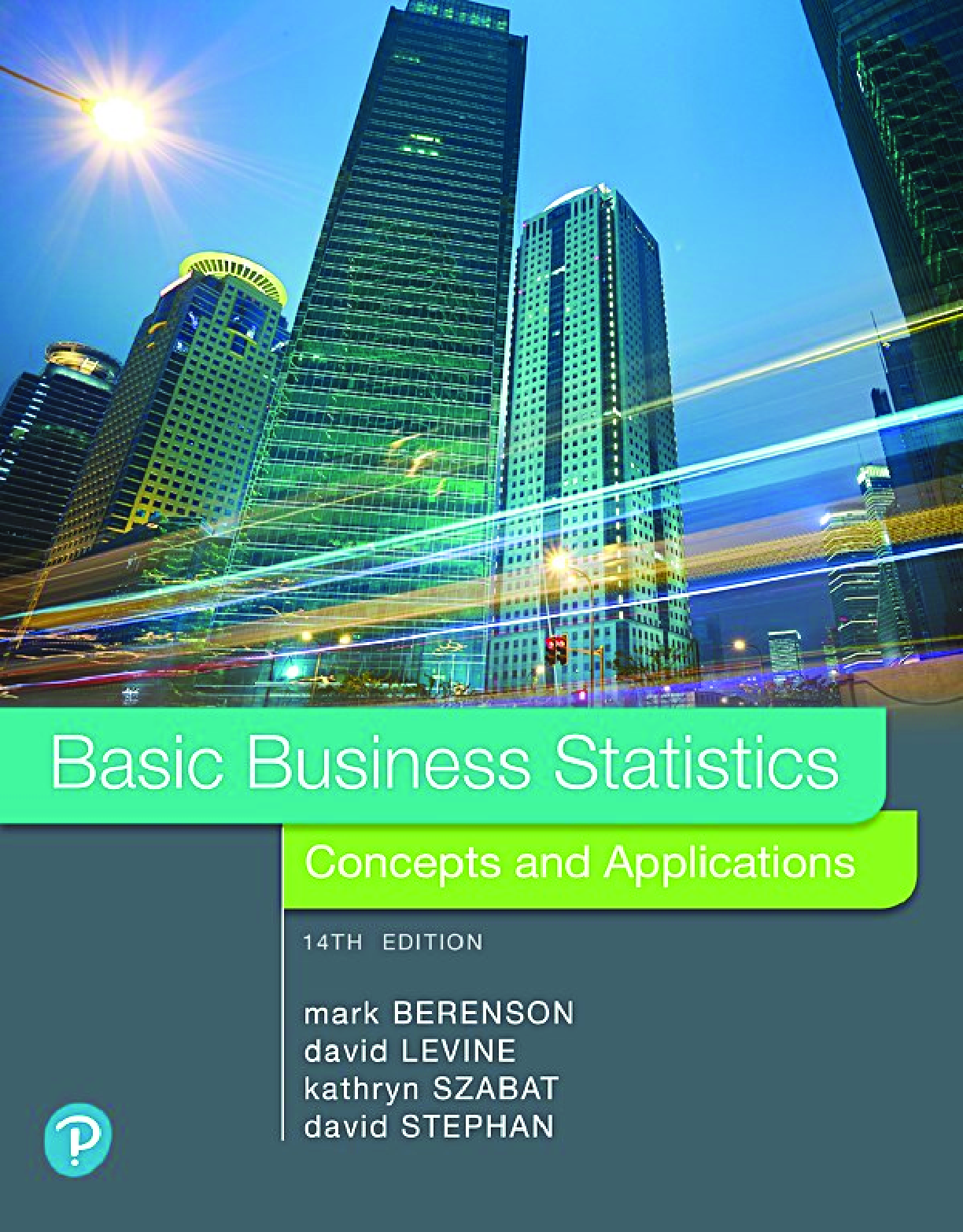
Buy this document to get the full access instantly
Instant Download Access after purchase
Buy NowInstant download
We Accept:

Reviews( 0 )
$25.00
Can't find what you want? Try our AI powered Search
Document information
Connected school, study & course
About the document
Uploaded On
Dec 23, 2022
Number of pages
600
Written in
Additional information
This document has been written for:
Uploaded
Dec 23, 2022
Downloads
0
Views
140



